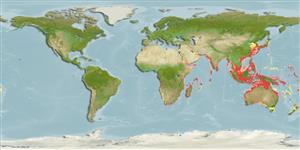Environment: milieu / climate zone / depth range / distribution range
Écologie
marin; saumâtre démersal; océanodrome (Ref. 51243); profondeur 1 - 100 m (Ref. 9830). Tropical
Indo-West Pacific: East Africa to the Philippines and Japan, south to New Guinea, the Arafura Sea (Ref. 9819), Australia, New Caledonia and Fiji.
Length at first maturity / Taille / Poids / Âge
Maturity: Lm 93.2 range ? - ? cm
Max length : 200 cm TL mâle / non sexé; (Ref. 559); common length : 150 cm TL mâle / non sexé; (Ref. 2871); poids max. publié: 7.1 kg (Ref. 40637)
Épines dorsales (Total) : 0; Épines anales: 0; Vertèbres: 128 - 141. Body robust and eel-shaped; snout long; eye diameter 3 times in snout length (Ref. 4832). Head narrower, interorbital width about 10 times in head; lateral-line pores before anus 33-39; dorsal-fin rays before anus 47-49 (Ref. 9830). Posterior nostrils only slightly nearer to eye than to anterior nostrils; mouth very large; teeth generally large and conspicuous (Ref. 4832).
Found in coastal waters, including estuaries; sublittoral above 100 m (Ref. 11230). Feeds on benthic fishes and crustaceans (Ref. 9830). Nocturnal. Known to attack fishers or anglers after being captured (Ref. 6590). Also caught by drift net and bag (dol) nets. Marketed mainly fresh. Minimum depth reported taken from Ref. 86942.
van der Elst, R., 1981. A guide to the common sea fishes of southern Africa. C. Struik, Cape Town. 367 p. (Ref. 3670)
Statut dans la liste rouge de l'IUCN (Ref. 130435: Version 2024-1)
Menace pour l'homme
Other
Utilisations par l'homme
Pêcheries: commercial; pêche sportive: oui
Outils
Articles particuliers
Télécharger en XML
Sources Internet
Estimates based on models
Preferred temperature (Ref.
123201): 21.7 - 29.1, mean 28 °C (based on 2108 cells).
Phylogenetic diversity index (Ref.
82804): PD
50 = 0.6250 [Uniqueness, from 0.5 = low to 2.0 = high].
Bayesian length-weight: a=0.00204 (0.00124 - 0.00337), b=2.92 (2.77 - 3.07), in cm total length, based on LWR estimates for this species & (Sub)family-body (Ref.
93245).
Niveau trophique (Ref.
69278): 4.0 ±0.67 se; based on food items.
Generation time: 6.1 ( na - na) years. Estimated as median ln(3)/K based on 1
growth studies.
Résilience (Ref.
120179): Haut, temps minimum de doublement de population inférieur à 15 mois (Fec=17,475).
Prior r = 0.76, 95% CL = 0.50 - 1.14, Based on 1 full stock assessment.
Fishing Vulnerability (Ref.
59153): High vulnerability (62 of 100).
